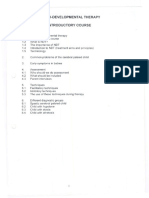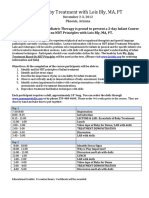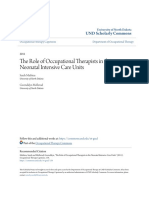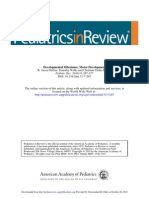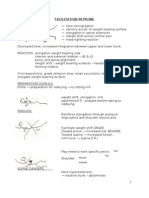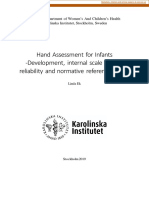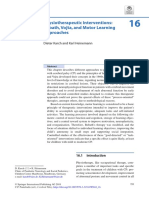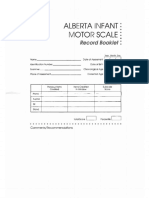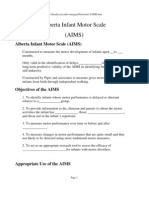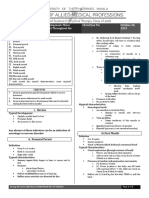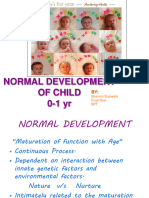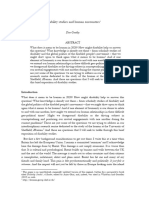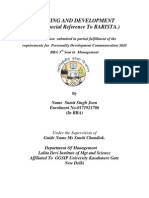Motor Development from Birth to Twelve Months
Amy S. OMalley, PT, MPT
Good Beginnings Falls Church, VA, USA Firefly, Inc.
�This presentation is made possible, in part, by the support of the American people through the United States Agency for International Development (USAID). The content of this presentation is the sole responsibility of the author(s) and does not necessarily reflect the views of USAID or the United States Government. The opinions and views expressed by the authors in this document do not necessarily reflect the views and opinions of KPMG.
�A month to month overview-why?
The first year of life is a wonderful compilation of sequential activities. Each one purposefully builds on the previous to allow for the development of:
Independent locomotion (gross motor) Independent use of bilateral upper extremities (fine motor) Independent verbal and nonverbal skills (communication)
If one component skill is unattained, further development becomes difficult.
�Month to Month (cont.)
Understanding the basic components and when milestones are expected to be achieved is ESSENTIAL to designing intervention Skills must be acquired in a relatively sequential order to be successful (i.e. you cannot run before you walk, walk before you sit, etc.) General principles
Cephalo-caudal (head to foot) Proximal-distal (from the core to the extremities) Gross motor-fine motor (large movements before small, refined movements)
�Birth to One Month (Neonatal Period)
Typical gestation is 38-42 weeks Purpose: learn to tolerate extrauterine environment Sensory input Feeding Sleeping Physiologic flexion dominates Pull to sit is completely passive Unable to contract UE/abd/LE muscles to assist Neck muscles may contract, but head is too heavy for lifting
�Neonate (cont.)
Reflexes and gravity dominate
Moro reflex: Sudden backwards movement of the head causes UE abd/ext. followed by add/flex. Rooting reflex: Tactile stimulation to the mouth in supine causes head rotation
Can clear head to the cheek to either side while prone (prevents suffocation)
�Potential Indicators of Atypical Motor Development-Perinatal
Profound Medical History
Prematurity Intraventricular Hemmohage (Grade III/IV) Bronchopulmonary Dysplasia (BPD) Very low birth weight (under 1500 grams) Perinatal aspyhxia
Neurological insults will either result in a very stiff (hypertonic or spastic) or floppy (hypotonic) muscle pattern
�First Month (4-8 weeks)
Purpose: eat, sleep, emotionally bond with caregivers, visual exploration Supine
Random extremity movements Head rotation Head lifting and turning (requires maximum effort) Emerging tracking in horizontal plane of a high contrast, black and white object/picture
Prone
Visual
Pull to sit is still passive, but infant tries to assist
�Second Month (8-12 weeks)
ATNR (asymmetric tonic neck reflex) dominates
Head rotation causes extension of face side arm and flexion of skull side arm
Vision
Brief fixation at midline Tracking side to midline/midline to side
�Second month (8-12 weeks) (cont.)
Prone
Brief lifting of head to 45
Pull to sit
Head lag continues despite attempts to assist UE produce some active elbow flexion
�Third Month (12-16 weeks)
Symmetry returns ATNR starting to integrate, but not fully Can hold head in midline Can hold a rattle placed in the hand Can play with the hands together
�Third month (1216 weeks) (cont.)
Prone
VERY important to have a lot of tummy time Able to lift head between 45-90 Can track horizontally 180
Pull to sit
Head lag persists until nearly upright, then some flexion occurs
�Potential Indicators of Atypical Motor Development-3 months
Inability to keep head in midline Inability to lift head while prone Inability to bear weight on the UE while prone Inability to focus visual gaze
�Fourth Month (16-20 weeks)
The beginnings of movements that are:
Controlled and purposeful Alternating and coordinated
Symmetry extends down through the head and trunk ATNR should be rarely seen
�Fourth month (16 to 20 weeks) (cont.)
Prone
90 on elbows Head in midline
Pull to sit
Head righting strong/chin tuck Stabilized in midline with shoulders
Rolling begins via reflexive action
Supine to side Prone to side
Sitting begins with support
Brief periods of maintaining position without support (a few seconds)
�Potential Indicators of Atypical Motor Development-4 months
Continued asymmetry
Overuse of ATNR reflex Inability to keep head in midline in either prone or supine Inability to visually track objects Lack of UE muscle contraction during pull to sit Inability to achieve a sitting position with support
�Fifth Month (20-24 weeks)
Characterized by movement that is:
Voluntary Asymmetrical Dissociated Reciprocal
Head control and righting are present in all positions Hands to feet emerges
�Fifth month (20-24 weeks) continued
Prone on extended elbows Rolling
Active from supine to side Accidental from prone to supine
Pull to sit
Flexes and lifts head when holding hands Abdominal begin to contract
Sitting
Independent briefly but through positional stability LEs are in ring position Prop sitting with UEs
Play involves grabbing, mouthing, banging, shaking a small toy in hand
�Potential Indicators of Atypical Motor Development-5 months
Lack of flexion control (unable to reach hands to knees/feet)
Weak abdominals/lack of kicking LEs Lack of choice between asymmetry and symmetrical use of UEs Unable to stabilize head in supported sitting Unable to attempt to straighten back in supported sitting
Weak use of spinal extensors
Inability to achieve weight bearing on ischial tuberosities in supported sitting
�Sixth Month (24-28 weeks)
Head control fully developed for prone, supine, and sidelie Feet to mouth Pulls to sit holding hands Sits independently
No propping No external support
Bears full weight on LEs in supported standing
�Sixth month (24-28 weeks) continued
Prone
Functional and mobile Prone on extended arms (POEE) Weight shift on extended arms Pivot prone in a circle Reach to front and side for toys
Rolling
Active supine to prone Head righting is present during the movement
�Potential Indicators of Atypical Motor Development-6 months
Inability to sit Inability to be active in prone Inability to roll Inability to correct head position
�Seventh Month (28-32 weeks)
Very rarely in supine Active play in sidelye Sit independently
Back and pelvis straight Can manipulate toys while in base of support (BOS) Frequent falls backwards Uses protective extension when falling forward
�Seventh month (28-32 weeks) continued
Prone
Pushes up into quadruped Rocking in quadruped
Creeping
Sometimes called belly or commando crawling
Can be supported in standing at trunk or hands
�Potential Indicators of Atypical Motor Development-7 months
Preference for supine over prone Inability to roll Inability to sit Lack of motivation to move Compensations to accomplish ageappropriate tasks
Head/neck hyperextension while sitting Extra wide BOS during sitting
�Eighth Month (32-36 weeks)
MOVEMENT!
Multiple LE positions in sitting
Ring sitting when focused on UE play ring long sit Long sit Side sit
Transitions in/out of quadruped
Pre-vaulting over hip Controlled back to floor
�Eighth Month (32-36 weeks) continued
Crawling emerges
Hands and knees Reciprocal extremity movement
Pull to stand with UEs
Kneeling Standing at a surface or holding onto fingers
�Potential Indicators of Atypical Motor Development-8 months
Inability to sit
Inability to vary sitting positions
Lack of transitions between floor, sitting, and quadruped
Standing on tiptoes
�Ninth Month (36-40 months)
FLOOR MOBILITY
Combining gross and fine motor skills
Crawling
Varied speeds
Quickly changes directions
Climbing
Stairs, furniture
Can climb up but not down
�Ninth Month (36-40 months) (cont.)
Standing
Squat to floor with hand on surface Moving to floor not always controlled
Cruising
Along the furniture Lateral (side to side) is the first pattern
�Potential Indicators of Atypical Motor Development-9 months
Sitting only in ring sit or w-sit
Inability to transition between positions Bunny hopping during crawling
�Tenth Month (40-44 weeks)
Actively exploring environment
Concepts of in and out/container play Crawling and climbing are primary, rarely sitting
Can crawl over objects Starting to motor plan going down
�Tenth Month (40-44 weeks) continued
Kneeling and half kneeling
LEs contribute to pull to stand Standing with hands manipulating objects Cruising
Lateral Around furniture
Supported walking
�Eleventh Month (44-48 weeks)
Independent standing
Can pull to stand at furniture, on a person, along the wall
Squatting
Cruise around and over furniture
Must be taught to descend backwards
Walking
With one hand held May attempt to take independent steps
�Twelfth Month (48-52 weeks)
Basic motor skills are all present
All transitions are independent
Moving floor to stand with out a surface is new
Stand independently without support Independent walking may begin but is not obligatory
�Potential Indicators of Atypical Motor Development10-12 months
Inability to perform any of the ageexpected tasks
Poor quality of movement during ageappropriate tasks
Poor velocity of movement during ageappropriate tasks
�References
Bly, Lois, M.A., PT Motor Skills Acquisition in the First Year. Therapy Skill Builders, San Antonio, Texas, 1994.




















